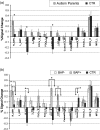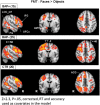Abnormal Neural Activation to Faces in the Parents of Children with Autism
- PMID: 25056573
- PMCID: PMC4635912
- DOI: 10.1093/cercor/bhu147
Abnormal Neural Activation to Faces in the Parents of Children with Autism
Abstract
Parents of children with an autism spectrum disorder (ASD) show subtle deficits in aspects of social behavior and face processing, which resemble those seen in ASD, referred to as the "Broad Autism Phenotype " (BAP). While abnormal activation in ASD has been reported in several brain structures linked to social cognition, little is known regarding patterns in the BAP. We compared autism parents with control parents with no family history of ASD using 2 well-validated face-processing tasks. Results indicated increased activation in the autism parents to faces in the amygdala (AMY) and the fusiform gyrus (FG), 2 core face-processing regions. Exploratory analyses revealed hyper-activation of lateral occipital cortex (LOC) bilaterally in autism parents with aloof personality ("BAP+"). Findings suggest that abnormalities of the AMY and FG are related to underlying genetic liability for ASD, whereas abnormalities in the LOC and right FG are more specific to behavioral features of the BAP. Results extend our knowledge of neural circuitry underlying abnormal face processing beyond those previously reported in ASD to individuals with shared genetic liability for autism and a subset of genetically related individuals with the BAP.
Keywords: amygdala; autism; broad autism phenotype; face perception; fusiform gyrus.
© The Author 2014. Published by Oxford University Press. All rights reserved. For Permissions, please e-mail: journals.permissions@oup.com.
Figures





References
Publication types
MeSH terms
Grants and funding
LinkOut - more resources
Full Text Sources
Other Literature Sources
Medical

